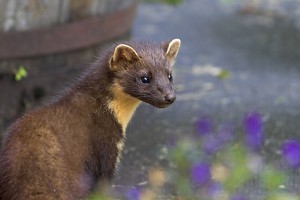You may be lucky enough to spot a Pine Marten. These rare members of the weasel family were never eradicated in Argyll, and now have returned to much of Scotland. From a low point around the beginning of the twentieth century, where they had been virtually wiped out through loss of habitat and human predation, they can now be found in most mainland areas except for the densely populated central belt
They are about the same size as a domestic cat, but are omnivorous and also partly arboreal, with incredible climbing skills. It is believed that grey squirrels are deterred from entering Marten areas because Martens find them easier to catch than the smaller, more agile reds. Paradoxically, this means that although Martens will happily prey on red squirrels, the reds tend to do better in areas where Martens are more common.
In this area Pine Martens are relatively common, although you can consider yourself lucky if you see one pursuing a squirrel through the trees. They frequently visit bird tables and squirrel feeders for nuts and raisins (reputedly also jam and peanut butter), and are also very fond of (and can rapidly ruin) soft fruit crops. The scat of a Marten has a distinctive twisted appearance, and (apparently) smells of parma violets.
Stop Press A pine marten has started regularly visiting our bird table.Although foxes and golden eagles may attack Martens, their main threat is from human beings (illegal poisoning and shooting by gamekeepers) and destruction of their habitat. The Donich woodlands are perfect territory for Pine Martens, combining a rich source of food with a large area sparsely populated by humans.

